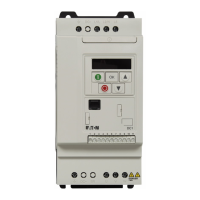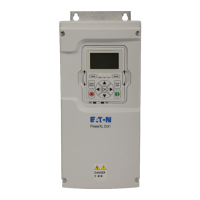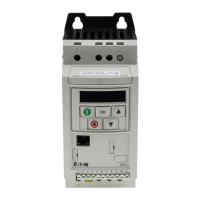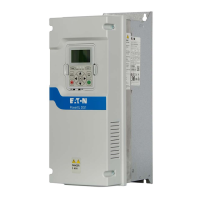49
EtherNet/IP On-Board Communications
POWERXL SERIES VFD MN040010EN—June 2018 www.eaton.com
EtherNet/IP
Overview
EtherNet/IP (Ethernet/Industrial Protocol) is a
communication system suitable for use in industrial
environments. EtherNet/IP allows industrial devices to
exchange time-critical application information. These devices
include simple I/O devices such as sensors/actuators,
as well as complex control devices such as robots,
programmable logic controllers, welders, and process
controllers. EtherNet/IP uses CIP (Control and Information
Protocol), the common network, transport, and application
layers also shared by ControlNet and EtherNet/IP. EtherNet/
IP then makes use of standard Ethernet and TCP/IP
technology to transport CIP communications packets. The
result is a common, open application layer on top of open
and highly popular Ethernet and TCP/IP protocols.
EtherNet/IP messaging forms.
•
Unconnected messaging is used for connection
establishment and for infrequent, low-priority messages
•
Connected messaging uses resources that are dedicated
in advance to a particular purpose such as real-time I/O
data transfer
EtherNet/IP messaging connections.
•
Explicit messaging connections are general purpose
point-to-point connections. Messages are sent through
TCP protocol
•
Implicit (I/O data) connections are established to move
application-specific I/O data at regular intervals. They are
often set up as one-to-many relationships in order to take
full advantage of the producer-consumer multicast model.
Implicit messages are sent through UDP protocol
AC/DC drive profile
In order to provide compatibility between similar devices
from different manufacturers, there a defined “standard” in
which those devices.
•
Exhibit the same behavior
•
Produce and/or consume the same basic set of I/O data
•
Contain the same basic set of configurable attributes.
The formal definition of this information is known as a
deviceprofile.
EDS File
EDS—Is the abbreviation for Electronic Data Sheet, a file on
disk that contains configuration data for specific device types.
You can provide configuration support for your device by
using a specially formatted ASCII file, referred to as the EDS.
The information in an EDS allows configuration tools to
provide informative screens that guide a user through the
steps necessary to configure a device. An EDS provides
all of the information necessary to access and alter the
configurable parameters of a device. This information
matches the information provided by instances of the
parameter object class. The CIP object library describes the
parameter object class in detail.
Explicit messaging
Explicit Messaging is used in commissioning and
parameterizing of the EtherNet/IP board. Explicit messages
provide multipurpose, point-to-point communication paths
between two devices. They provide the typical request/
response-oriented network communication used to
perform node configuration and problem diagnosis. Explicit
messages typically use low priority identifiers and contain
the specific meaning of the message right in the data field.
This includes the service to be performed and the specific
object attribute address.
ote: N If Class 1 connection (cyclic data) has been
established, then explicit messages cannot be used
to control output data. However, this restriction
doesn’t apply for IO Data reading.
List of object classes
The communication interface supports the following
objectclasses.
Table 61. List of object classes
Class Object Remark
0x01 Identity objects CIP required object
0x04 Assembly object CIP object for drive device
0x06 Connection manager object Communication object
0x28 Motor data object CIP object for drive device
0x29 Control supervisor object CIP object for drive device
0x2A Ac/dc drive object CIP object for drive device
0xA0 Vendor parameters object CIP object for drive device—
vendor specific
0xA1 Vendor parameter object Please refer to Appendix A
0xA2 Vendor parameter object Please refer to Appendix A
0xA3 Vendor parameter object Please refer to Appendix A
0xA4 Vendor parameter object Please refer to Appendix A
0xA5 MPFC parameter object Please refer to Appendix A
0xF5 TCP/IP Interface Object CIP required object
0x02 Message router object Communication object
0xF4 Port object Communication object
0xF6 Ethernet link object CIP required object

